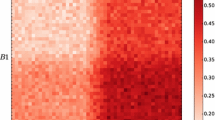Abstract
Visualizing and interpreting regression coefficients from spatially varying coefficient models, such as geographically weighted regression (GWR), can be challenging, given the amount of information the models provide the spatial analyst. Adding to the visualization dilemma are various diagnostic tools for checking the coherence of the model. One such diagnostic tool is based on decomposing the regression coefficient variance matrix to test for collinearity, which is relevant because previous research has shown that collinearity in GWR can lead to estimated regression coefficients for multiple regression terms that are strongly correlated with each other. In this paper, visualization tools, such as linked scatter plots, parallel coordinate plots, and maps, are presented for diagnosing correlation in estimated regression coefficients that can be problematic for statistical inference of relationships between variables. These tools help explain patterns of dependence between regression terms apparent in scatter plots of estimated coefficients and link the structure in the scatter plots to locational information in a map. Visualization of this information should aid in the typical spatially varying coefficient model estimation process. A case study of census undercount in Franklin County, Ohio is presented as an illustrative example of applying the visual diagnostic approach in a GWR analysis.
Access this chapter
Tax calculation will be finalised at checkout
Purchases are for personal use only
Similar content being viewed by others
References
Anselin, L. (2003). GeoDa 0.9 user’s guide. (Urbana-Champaign, IL: Spatial Analysis Laboratory (SAL), Department of Agricultural and Consumer Economics, University of Illinois
Belsley, D.A. (1991). Conditioning diagnostics: collinearity and weak data in regression. (New York: John Wiley & Sons)
Chambers, J.M., Cleveland, W.S., Kleiner, B. & Tukey, P.A. (1983). Graphical methods for data analysis. (Pacific Grove, CA: Wadsworth & Brooks/Cole)
Cleveland, W.S. & McGill, M.E. (1988). Dynamic graphics for statistics. (Monterey, CA: Wadsworth)
Darga, K. (1998). Straining out gnats and swallowing camels: the perils of adjusting for census undercount. Office of the State Demographer, Michigan Information Center, Michigan Department of Management and Budget
ESRI (2005). ArcGIS 9.1 Users Guide
Fotheringham, A.S., Brunsdon, C. & Charlton, M. (2002). Geographically weighted regression: the analysis of spatially varying relationships. (West Sussex: John Wiley & Sons)
Griffith, D. (2008). Spatial filtering-based contributions to a critique of geographically weighted regression (GWR). Environmental and Planning A, 40, 2751–2769
Inselberg, A. (1985). The plane with parallel coordinates. The Visual Computer, 1, 69–91
Moustafa, R. & Wegman, E. (2006). Multivariate continuous data – parallel coordinates. In A. Unwin, M. Theus & H. Hofmann (Eds.), Graphics of large datasets: visualizing a million (pp. 143–155). (Berlin: Springer)
Neter, J., Kutner, M.H., Nachtsheim, C.J. & Wasserman, W. (1996). Applied linear regression models. (Chicago: Irwin)
Spiegelhalter, D.J., Best, N.G., Carlin, B.P. & van der Linde, A. (2002). Bayesian measures of model complexity and fit (with discussion). Journal of the Royal Statistical Society, Series B, 64, 583–640
Steffey, D.L. (1997). A review of the census undercount issue. Faculty Fellows Program, Center for California Studies, California State University
Tierney, L. (1990). LISP-STAT: an object oriented environment for statistical computing and dynamic graphics. (Chichester: Wiley)
Tukey, J.W. (1977). Explanatory data analysis. (Reading, MA: Addison-Wesley)
Venables, W.N. & Smith, D.M. (2002). An introduction to R. (Bristol: Network Theory Limited)
Waller, L., Zhu, L., Gotway, C., Gorman, D. & Gruenewald, P. (2007). Quantifying geographic variations in associations between alcohol distribution and violence: A comparison of geographically weighted regression and spatially varying coefficient models. Stochastic Environmental Research and Risk Assessment, 21(5), 573–588
Wegman, E. (1990). Hyperdimensional data analysis using parallel coordinates. Journal of the American statistical association, 85, 664–675
Wheeler, D.C. (2009). Simultaneous coefficient penalization and model selection in geographically weighted regression: The geographically weighted lasso. Environment and Planning A, 41, 722–742
Wheeler, D.C. (2007). Diagnostic tools and a remedial method for collinearity in geographically weighted regression. Environment and Planning A, 39(10), 2464–2481
Wheeler, D.C. & Calder, C. (2007). An assessment of coefficient accuracy in linear regression models with spatially varying coefficients. Journal of Geographical Systems, 9(2), 145–166
Wheeler, D.C. & Tiefelsdorf, M. (2005). Multicollinearity and correlation among local regression coefficients in geographically weighted regression. Journal of Geographical Systemsm, 7, 161–187
Author information
Authors and Affiliations
Corresponding author
Editor information
Editors and Affiliations
Rights and permissions
Copyright information
© 2010 Springer Science+Business Media B.V.
About this chapter
Cite this chapter
Wheeler, D.C. (2010). Visualizing and Diagnosing Coefficients from Geographically Weighted Regression Models. In: Jiang, B., Yao, X. (eds) Geospatial Analysis and Modelling of Urban Structure and Dynamics. GeoJournal Library, vol 99. Springer, Dordrecht. https://doi.org/10.1007/978-90-481-8572-6_21
Download citation
DOI: https://doi.org/10.1007/978-90-481-8572-6_21
Published:
Publisher Name: Springer, Dordrecht
Print ISBN: 978-90-481-8571-9
Online ISBN: 978-90-481-8572-6
eBook Packages: Earth and Environmental ScienceEarth and Environmental Science (R0)




